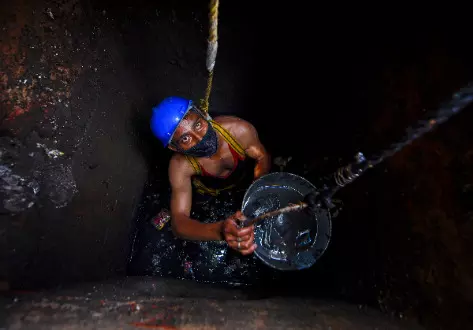No data, no compensation: Injured sewer workers slip through legislative and legal cracks

New Delhi: On a cold February morning in 2020, Sanjay, a sanitation worker, in his forties, from Delhi's Seemapuri, was called in a hurry by a local contractor. A political rally was scheduled nearby, and “the sewer was overflowing”.
He was promised Rs 300. “It was urgent and the money was good, so we went,” Sanjay said.
Three men climbed down that day, but only one made it out alive.
Inside the narrow pit, thick with the stench of toxic gases, Sanjay’s co-workers fell unconscious within minutes. “Then they pushed me to go inside and check,” Sanjay said.
He remembers nothing after that but only waking up, 13 days later, in a hospital bed with tubes running through his nose and throat.
Sanjay’s medical records from the Lok Nayak Hospital mention “acute sewer gas poisoning” and “pneumonitis” – lung inflammation caused by inhaling toxic gases such as hydrogen sulfide and methane.
He suffered seizures, needed mechanical ventilation, and narrowly survived. And the scars of that day remain etched in his body and mind.
“My stomach hurts all the time, my breathing is heavy, my heart races,” he said, pointing to a small plastic bag of pills he can no longer afford.
“I drink alcohol now to fight the pain. It’s cheaper than medicine.”
Sanjay’s mother, now 70, spends her days stitching elastic onto garment tags, earning Rs 30 a day. Their small, single-room house is crumbling; walls are cracked and damp, and the ceiling sagging dangerously.
“We haven’t repaired anything since his accident. Whatever little we have goes into rent and food,” she said.
Despite nearly losing his life inside a sewer, Sanjay never received compensation. There was no inquiry, no official acknowledgment, no rehabilitation.
And, Sanjay’s story is not an exception -- it is a pattern.
This year on March 28, the Supreme Court directed every metropolitan city to pay Rs 30 lakh compensation to the kin of those who die due to manual scavenging within four weeks.
But when it comes to injuries, the law turns vague, advocate Areeb Uddin Ahmed, who has worked on multiple sanitation workers’ cases, said.
There is no fixed compensation formula for people like Sanjay, neither are any official data maintained.
An RTI response received by PTI from the National Commission of Safai Karamcharis clearly states, “According to the record available with the Commission, no information related to people injured while cleaning sewer and septic tanks and the compensation provided to them (from 2014-15 to 2024-25) were reported to the Commission”.
Each case is treated “on a case-to-case basis”, often meaning no action at all, especially for sanitation workers like Sanjay, who can barely afford two meals a day, let alone pursue a lawsuit.
“While deaths are counted and duly compensated, the injured are forgotten. Many workers who survive toxic exposure live with chronic lung damage, kidney failure or neurological problems, but they are invisible to the state,” said activist Ashok Kumar Taank, joint secretary of the Dalit Adivasi Shakti Adhikar Manch, an organisation working for sanitation workers’ rights.
Soni is another victim who slipped through these legal cracks.
Her husband, Sher Singh, survived five years after inhaling toxic sewer gases, suffering from lung scarring, kidney damage, hepatitis and tuberculosis before meeting a painful end.
“He couldn’t breathe, he couldn’t eat properly. Medicines drained our savings,” Soni recalled.
When he died in 2024, she couldn’t even afford to pay for his funeral.
“I had to borrow money just to perform his last rites. He was humiliated even in death. Even after all this, the government says I’m not entitled to compensation. He died a slow, painful death because of his job of cleaning sewers. And yet, we remain invisible,” Soni said.
All of Soni's four children dropped out of school after Singh’s accident. They now help their mother in segregating waste, one as young as 10 years old.
“We make Rs 200 per day by segregating waste. But most of the money goes to the debt collectors, there are days when we get nothing to eat,” she said.
Yet, there are workers like 50-year-old Rakesh Kumar, who keeps cleaning sewers even though his lungs and kidneys are badly damaged.
He says contractors now hesitate to hire him, fearing he could succumb to his injuries while at work. “I take nebuliser every day. Without it, I can’t breathe,” he said.
Years of exposure to sewer gases has left him thin and frail, his frame little more than bone and skin.
Rakesh started cleaning sewers when he was 10. “My friends taught me. I thought it was easy. We even found gold chains and rings sometimes,” he said.
For his community, Valmikis, sewer work passes from generation to generation. “This is all I know,” he said.
The 2013 Manual Scavenging Act prohibits hazardous cleaning of sewers or septic tanks without safety gear, and mandates protective equipment, gas testing, and rescue readiness.
Yet, implementation remains weak, and informal contracting blurs accountability.
Advocate Ahmed said in case of disability due to such work, the compensation depends on severity with a minimum of Rs 10 lakh for partial disability, and Rs 20 lakh if the disability is permanent or results in economic helplessness.
But for internal or long-term injuries such as kidney or lung impairment caused by exposure during sanitation work, the Supreme Court order does not define any specific clause for compensation, he said.
“These are not explicitly covered under the existing statutory provisions. However, such cases can be categorised under disability depending on medical assessment of severity and impact on livelihood. If the injury results in economic incapacitation, the Rs 10-20 lakh compensation scale is generally applicable,” he said.
Occupational health expert Dr Ashish Mittal said that survivors of sewer gas poisoning often suffer long-term damage that is “invisible to the eye”.
“Hydrogen sulfide, methane, and ammonia can cause acute respiratory distress, neurological damage, and long-term lung fibrosis,” he said.
“Even if a person survives, he may develop chronic bronchitis or kidney dysfunction over time.”
Mittal explained that post-exposure symptoms such as fatigue, chest tightness, and breathlessness can persist for years.
“Many of these workers are discharged after short-term treatment, but there’s no follow-up. By the time they return to hospitals, the damage is irreversible,” Mittal said.
Many sanitation workers do not retire, they succumb to their injuries before turning 60, he said.
Taank said that while there is national outrage after every death, there is no data or support system for those who survive with internal injuries.
“The government records deaths, not the survivors. But for every death, there are many who are unable to work again due to injuries,” he said.
Taank said his organisation has documented multiple cases in Delhi, where the survivors did not receive any compensation because they had no formal proof of employment or medical board certificate linking the injury to sewer work.
In a bid to eliminate manual cleaning, the government introduced the NAMASTE (National Action for Mechanised Sanitation Ecosystem) scheme by mechanising sewer and septic tank cleaning and providing rehabilitation, insurance, and capital subsidies to sanitation workers.
As of March 2025, 66,961 workers have been validated and 45,000 PPE kits distributed across 400 cities. But Taank said these numbers mask the reality on the ground.
“Much of Delhi’s cleaning is still manual, especially of septic tanks and private drains in the narrow lanes where machines are unable to reach. Private contractors call it ‘emergency work’ to bypass the law.
“The worker goes down with a rope and a bucket, and that is it… No safety gear. NAMASTE is a progressive scheme but without universal registration and strict municipal oversight, hazardous cleaning continues,” he said.
Back in Seemapuri, with no PPE kits available, Ramesh has devised his own way to gauge whether a drain is dangerous.
“If the cockroaches crawl out, it’s safe, meaning the gas isn’t deadly yet. But if they’re dead, that’s when you don’t go in,” he said.



